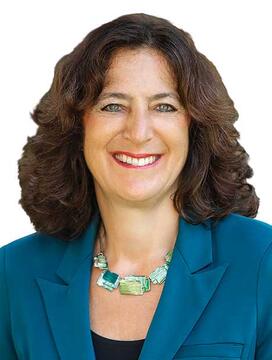Q&A: New Engineering Dean Plans for Growth, Diversity, Innovation
‘We need stronger ties to industry so our students can see what it’s like to be an engineer,’ Andrea Goldsmith says

Andrea Goldsmith became the dean of Princeton’s School of Engineering and Applied Science in September, and in her first year she’s made it a priority to improve diversity and develop plans to expand the school’s student body and physical footprint.
Before joining the University, she was a professor at Stanford. A leader in the development of wireless communications, in April 2020, Goldsmith became the first woman to win the Marconi Prize, the highest honor in telecommunications research. She is the chair of a diversity and inclusion committee for the Institute of Electrical and Electronics Engineers (IEEE). She also founded two companies and has 29 patents.
Goldsmith spoke to PAW about her journey to Princeton and her plans for the engineering school.
What interested you about a career in engineering?
I didn’t start out thinking that I was going to be an engineer. My dad was a mechanical engineering faculty member, so he suggested that I declare engineering when I started at the University of California, Berkeley, because it would be a lot easier to transfer out than to transfer in. My first year I was taking math and physics courses and working full time, and I did poorly. That summer, I took a step back and reevaluated. The next semester, I was taking an algebra class with a female TA, the first female math graduate student I’d actually seen. It was just so inspiring. I aced that class and caught up with my other studies, and I realized: OK, I can do this.
What advice would you offer students who struggle?
I like to say it’s good to fail early and often. I think it’s normal in your first year to question whether you really belong here, but having the resiliency to say, “I’m going to make that decision and I’m not going to let my failures or what other people think dictate whether I can overcome them or not” is important. It served me well in later challenges and failures, from not getting into my first choice (Stanford) for graduate school to the many times my two companies were on the brink of failure. I’m not afraid to take risks, and in many ways that has helped me get to where I am today.
Can you talk about how the gender gap in engineering impacted you?
You walk in a room and you’re viewed differently. I’ll tell you one anecdote: When I started my faculty position at Caltech, there were three offices in the complex where I was sitting, and my department chair’s office was next to me. Everyone assumed I was his administrative assistant just because I was next to him and I was female. Diverse people don’t get the same opportunities as nondiverse people, and that means the profession suffers as a result.
Why were you interested in becoming the engineering dean at Princeton?
I generally wasn’t interested in leadership roles at universities because I didn’t believe they would lead to significant impact. So when H. Vincent Poor [*77], who was interim dean of engineering and is a longtime friend and collaborator, suggested I apply, I told him I was unsure if I’d be able to have the impact I would want at a place like Princeton. He pointed me to the strategic plans for engineering developed in 2016, which were very bold and ambitious and included building a whole new neighborhood that would be a catalyst for collaboration within and across engineering and the entire University. I realized there is no better opportunity for me anywhere in the country to lead and have impact.
What priorities did you focus on in your first year?
A lot of my first year was strategic planning. There’s a number of things I did early on, particularly related to President Eisgruber [’83]’s call to combat systemic racism on campus. One was I put in place best practices for faculty hiring and crafted a very detailed action plan on diversity and inclusion, including anti-racism. We also increased the number of graduate students (35 additional students over two years) in engineering. Additionally, we are experimenting with a one-year master’s program for current seniors and members of the Class of 2020. We’ve had about 70 students apply to the program.
What about initiatives for undergraduate students?
The first year is where we lose a lot of our diverse students. So we’ve added a set of classes for first-year students that pose math and physics through the lens of engineering and how you need to learn these tools in order to apply them in ways that make the world a better place. Those classes have a tremendous retention rate of diverse students in STEM. Undergraduates who major in engineering sometimes go on to pursue other careers. I want to keep them in engineering because Princeton educates great leaders; we need stronger ties to industry so our students can see what it’s like to be an engineer.
Can you talk more about research collaborations with industry, such as the Google AI Lab in Princeton?
I think it hasn’t been a focus to really forge strong ties between industry and Princeton’s faculty and students. In my own experience, I was constantly talking to people in industry and I was funded by industry for a lot of my research. My former students were funded by people from industry and they got tremendously valuable opportunities from those relationships. Part of my strategic planning is finding ways to connect to industry.
Interview conducted and condensed by C.S.











No responses yet